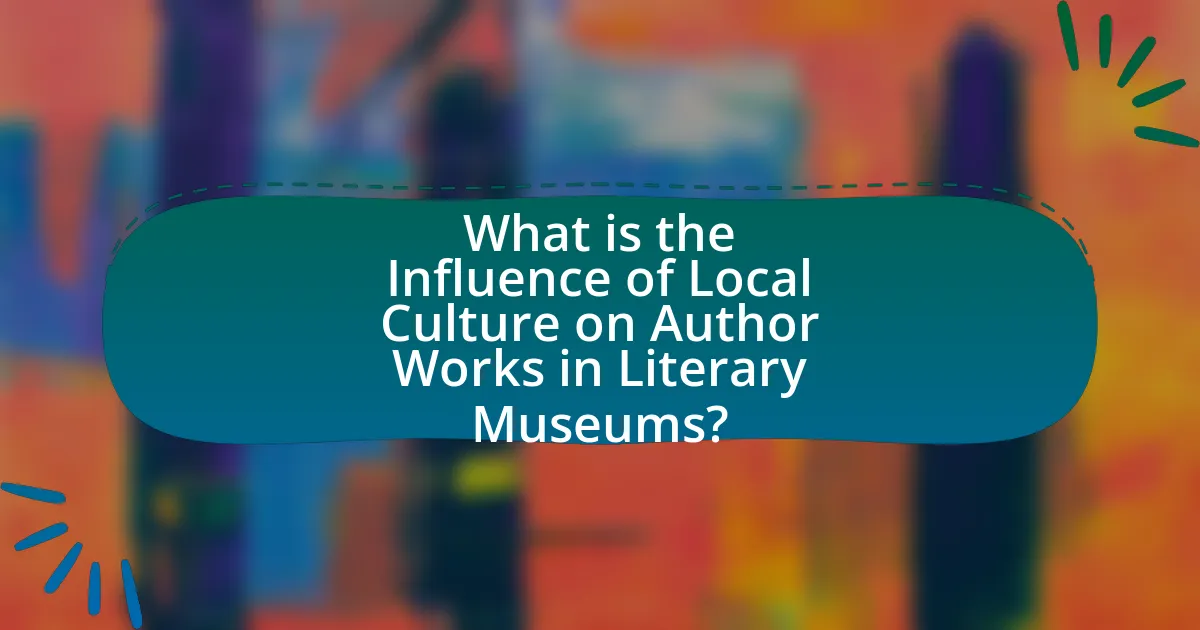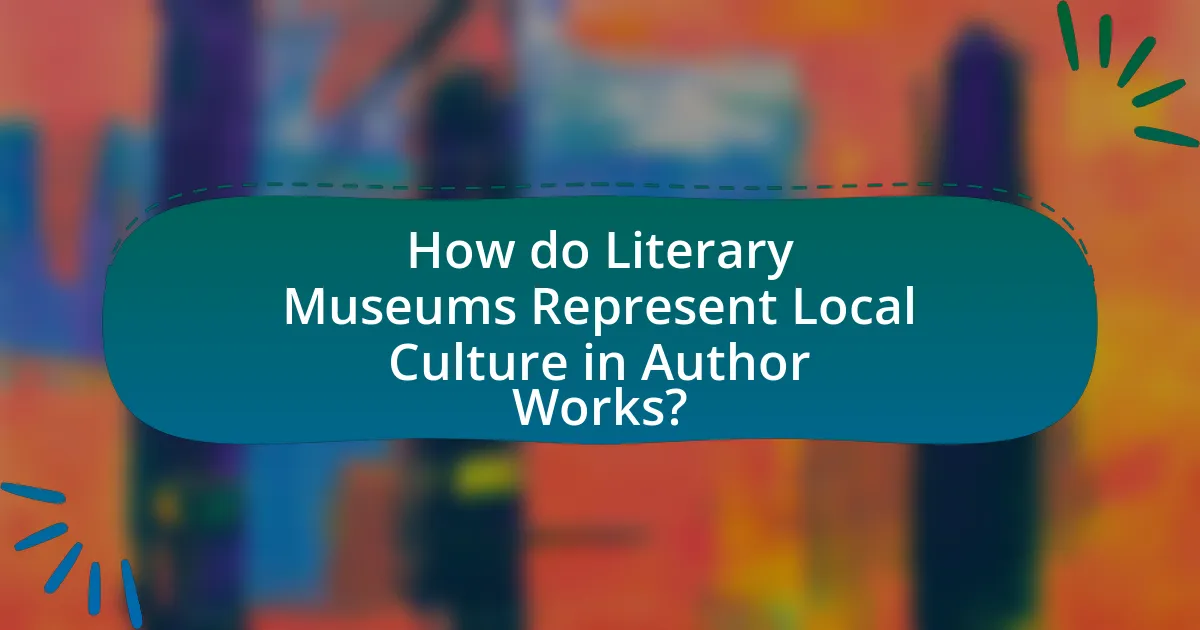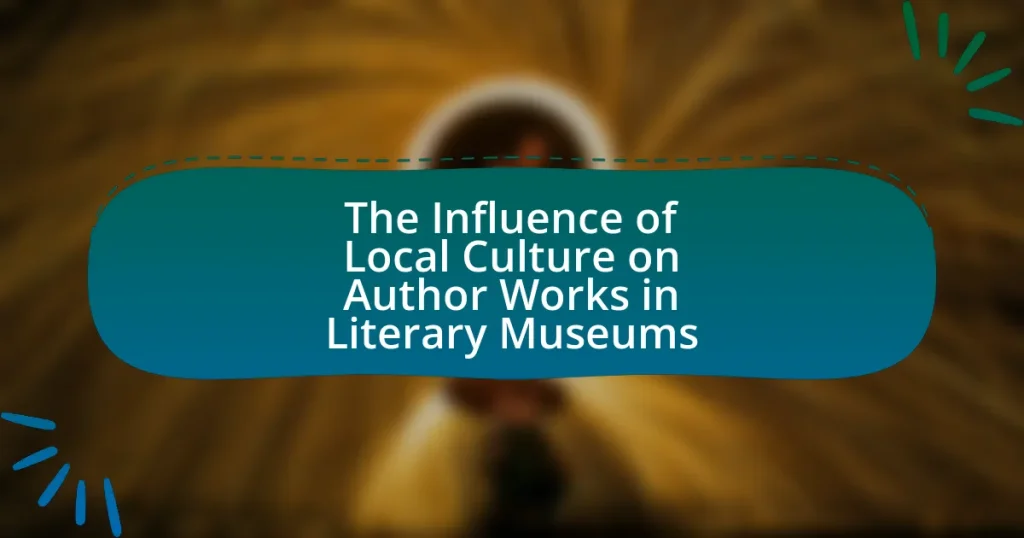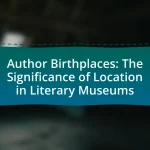The article examines the significant influence of local culture on the works of authors as represented in literary museums. It highlights how local traditions, dialects, and historical contexts shape themes, character development, and narrative styles in literature. The discussion includes specific cultural elements reflected in literary works, the role of literary museums in showcasing these connections, and the challenges faced in accurately representing local culture. Additionally, it emphasizes the importance of community engagement and collaboration in curating exhibits that authentically reflect the cultural heritage influencing authors’ creations.

What is the Influence of Local Culture on Author Works in Literary Museums?
Local culture significantly influences author works displayed in literary museums by shaping the themes, settings, and character development found in their writings. For instance, authors often draw inspiration from their surroundings, incorporating local traditions, dialects, and historical events into their narratives. This connection is evident in museums that showcase regional authors, where exhibits highlight how local folklore and societal norms have informed their literary contributions. A concrete example is the influence of the Southern Gothic tradition in the works of authors like William Faulkner, whose narratives reflect the complexities of Southern culture, including its history and social issues. Literary museums often curate collections that emphasize these cultural ties, providing context that enhances the understanding of the authors’ works and their relevance to local identity.
How does local culture shape the themes in an author’s works?
Local culture significantly shapes the themes in an author’s works by providing a unique context that influences their perspectives, values, and narrative choices. Authors often draw from the traditions, beliefs, and social dynamics of their local environment, which can manifest in the characters, settings, and conflicts within their stories. For example, the works of Gabriel García Márquez reflect the magical realism rooted in Latin American culture, illustrating how local folklore and historical events inform his themes of love, power, and identity. This connection between local culture and literary themes is evident in various authors, as cultural elements serve as a lens through which they explore universal human experiences.
What specific cultural elements are reflected in literary works?
Literary works reflect specific cultural elements such as traditions, values, social norms, and historical contexts. These elements are often depicted through character development, plot structure, and thematic exploration, showcasing the unique identity of a culture. For instance, the use of folklore and mythology in works like “Things Fall Apart” by Chinua Achebe illustrates the significance of oral traditions in Nigerian culture. Additionally, the portrayal of societal roles and family dynamics in novels like “Pride and Prejudice” by Jane Austen highlights the social norms of 19th-century England. Such representations provide insight into the cultural fabric of the societies from which these literary works emerge.
How do local traditions influence narrative styles?
Local traditions significantly influence narrative styles by shaping the themes, structures, and character development within stories. For instance, oral storytelling traditions often emphasize communal values and collective experiences, which can lead to narratives that prioritize group dynamics over individualism. This is evident in cultures where folklore and myths are integral, as seen in Native American storytelling, where the narrative often reflects the community’s relationship with nature and spirituality. Additionally, local dialects and idiomatic expressions enrich the narrative voice, making it more authentic and relatable to the audience. Research indicates that narratives rooted in specific cultural contexts resonate more deeply with readers familiar with those traditions, enhancing emotional engagement and understanding.
Why is it important to study the connection between local culture and literature?
Studying the connection between local culture and literature is important because it reveals how cultural contexts shape literary expression and themes. Local culture influences authors’ perspectives, allowing them to reflect societal values, traditions, and experiences in their works. For instance, literature often incorporates local dialects, folklore, and historical events, which enrich the narrative and provide authenticity. This connection is evident in works like Gabriel García Márquez’s “One Hundred Years of Solitude,” where the Colombian setting and cultural elements are integral to the story. Understanding this relationship enhances appreciation of literature and fosters a deeper comprehension of cultural identity and heritage.
What insights can be gained from understanding this relationship?
Understanding the relationship between local culture and author works in literary museums reveals how cultural context shapes literary expression. This insight highlights that authors often draw inspiration from their surroundings, reflecting societal values, traditions, and historical events in their writings. For instance, the works of Gabriel García Márquez are deeply influenced by Colombian culture, showcasing magical realism that resonates with local folklore and social issues. This connection allows literary museums to curate exhibits that not only celebrate the authors but also educate visitors about the cultural backdrop that informed their creations, enhancing appreciation and understanding of the literature.
How does this influence the preservation of literary heritage?
The influence of local culture on author works in literary museums significantly enhances the preservation of literary heritage by contextualizing the authors’ creations within their cultural backgrounds. This contextualization allows for a deeper understanding of the themes, styles, and motivations behind the works, which in turn fosters greater appreciation and engagement from the public. For instance, literary museums often showcase artifacts, manuscripts, and multimedia presentations that reflect the local culture, thereby creating a richer narrative around the authors’ lives and works. This approach not only preserves the physical artifacts but also ensures that the cultural significance of the literature is maintained, as evidenced by the success of museums like the Ernest Hemingway Home and Museum, which integrates local history and culture into its exhibitions, thereby preserving both the author’s legacy and the cultural context in which he wrote.

How do Literary Museums Represent Local Culture in Author Works?
Literary museums represent local culture in author works by showcasing artifacts, manuscripts, and exhibits that reflect the social, historical, and geographical contexts of the authors’ lives. These museums often curate collections that highlight the influences of local traditions, languages, and events on the authors’ writings, thereby providing visitors with a deeper understanding of how the local culture shaped the themes and narratives in their works. For example, the Ernest Hemingway Home and Museum in Key West emphasizes the author’s connection to the local environment and community, illustrating how these elements influenced his literary output. This representation is crucial for contextualizing the authors’ contributions within their cultural landscapes, allowing for a richer appreciation of their literature.
What role do literary museums play in showcasing local culture?
Literary museums play a crucial role in showcasing local culture by preserving and presenting the literary heritage of a region. These institutions curate collections that highlight the works of local authors, reflecting the unique cultural narratives, historical contexts, and social issues relevant to the area. For instance, the Ernest Hemingway Home and Museum in Key West not only displays Hemingway’s manuscripts but also illustrates the influence of Florida’s environment and culture on his writing. By organizing exhibitions, educational programs, and community events, literary museums foster a deeper understanding of how local culture shapes literary expression, thereby connecting visitors to the cultural identity of the region.
How do exhibitions highlight the cultural context of an author’s work?
Exhibitions highlight the cultural context of an author’s work by showcasing artifacts, manuscripts, and multimedia that reflect the author’s environment, influences, and societal conditions during their creative process. For instance, literary museums often include personal items, letters, and photographs that provide insight into the author’s life and the cultural milieu that shaped their narratives. This contextualization allows visitors to understand how local traditions, historical events, and social issues are interwoven into the author’s themes and characters, thereby enriching the interpretation of their work. By presenting these elements, exhibitions create a comprehensive narrative that connects the author’s literary contributions to the broader cultural landscape, enhancing appreciation and understanding among audiences.
What types of artifacts are commonly displayed to represent local culture?
Artifacts commonly displayed to represent local culture include traditional clothing, tools, crafts, and artworks. These items serve as tangible representations of the customs, practices, and historical narratives of a community. For instance, traditional clothing reflects the cultural identity and heritage of a region, while tools and crafts often illustrate the skills and livelihoods that have shaped local economies. Artworks, such as paintings or sculptures, can convey the aesthetic values and social themes prevalent in the culture. Collectively, these artifacts provide insight into the unique characteristics and historical context of the local culture they represent.
How do literary museums engage visitors with local cultural narratives?
Literary museums engage visitors with local cultural narratives by curating exhibits that highlight the connections between local authors and their cultural contexts. These museums often showcase artifacts, manuscripts, and multimedia presentations that reflect the historical and social influences on the authors’ works. For instance, the Ernest Hemingway Home and Museum in Key West emphasizes Hemingway’s experiences in Florida, illustrating how local culture shaped his writing. Additionally, interactive programs, such as guided tours and workshops, allow visitors to explore the narratives in a participatory manner, fostering a deeper understanding of the local cultural landscape and its impact on literary expression.
What interactive elements enhance the understanding of local culture in literature?
Interactive elements that enhance the understanding of local culture in literature include multimedia exhibits, guided tours, and participatory workshops. Multimedia exhibits, such as audio-visual presentations, provide context and background on local traditions and historical events that shape literary works. Guided tours often feature local authors or experts who share insights and anecdotes, deepening the audience’s connection to the literature. Participatory workshops allow visitors to engage directly with cultural practices, such as storytelling or traditional crafts, fostering a hands-on understanding of the cultural influences present in the literature. These elements collectively create an immersive experience that enriches the appreciation of local culture as reflected in literary works.
How do educational programs in museums promote cultural awareness?
Educational programs in museums promote cultural awareness by providing interactive learning experiences that highlight diverse cultural narratives and histories. These programs often include workshops, guided tours, and lectures that engage visitors with the cultural significance of artifacts and exhibitions. For instance, a museum might host a program focused on local authors, showcasing how their works reflect the cultural context of their time, thereby fostering a deeper understanding of the local heritage. Research indicates that such educational initiatives can enhance empathy and appreciation for different cultures, as evidenced by studies showing increased visitor engagement and positive feedback on cultural understanding after participating in museum programs.

What Challenges Exist in Representing Local Culture in Literary Museums?
Representing local culture in literary museums presents several challenges, primarily due to the complexity of cultural narratives and the diversity of community perspectives. Literary museums often struggle to accurately reflect the multifaceted nature of local culture, as it encompasses various traditions, languages, and histories that may not be easily represented through a singular narrative or exhibit. Additionally, the risk of oversimplification or misrepresentation arises when curators attempt to distill rich cultural elements into digestible formats for visitors.
For instance, a study by the American Alliance of Museums highlights that many museums face difficulties in engaging with local communities to ensure authentic representation, leading to potential alienation of cultural groups. Furthermore, the evolving nature of culture means that what is considered representative can change over time, complicating the task of maintaining relevance and accuracy in exhibits. These challenges necessitate ongoing dialogue with local communities and a commitment to inclusivity in the storytelling process within literary museums.
What are the common obstacles faced by literary museums in this representation?
Literary museums commonly face obstacles such as limited funding, which restricts their ability to curate exhibitions that accurately represent local culture and its influence on authors’ works. Additionally, a lack of public awareness and engagement can hinder visitor numbers, making it difficult for museums to showcase the significance of local cultural contexts. Furthermore, the challenge of balancing historical accuracy with contemporary relevance often complicates the representation of authors’ connections to their local environments. These factors collectively impede the effective portrayal of the interplay between local culture and literary heritage.
How do funding and resources impact the portrayal of local culture?
Funding and resources significantly influence the portrayal of local culture by determining the scope, quality, and accessibility of cultural representations. When adequate funding is available, literary museums can curate comprehensive exhibits that authentically reflect local traditions, histories, and narratives, thereby enhancing community engagement and education. For instance, the National Endowment for the Arts in the United States provides grants that enable museums to develop programs showcasing local authors and their works, which fosters a deeper understanding of regional culture. Conversely, limited resources can lead to superficial representations, neglecting important cultural elements and diminishing the overall impact of the museum’s offerings. This disparity highlights the critical role that financial support plays in shaping how local culture is presented and perceived within literary contexts.
What issues arise from cultural appropriation in literary exhibitions?
Cultural appropriation in literary exhibitions leads to issues such as misrepresentation, exploitation, and erasure of marginalized voices. Misrepresentation occurs when dominant cultures portray minority cultures inaccurately, often stripping away context and significance, which can distort public understanding. Exploitation arises when cultural elements are used for profit without proper acknowledgment or compensation to the originating communities, undermining their cultural heritage. Additionally, erasure happens when the contributions of marginalized authors are overshadowed or ignored, limiting their visibility and perpetuating systemic inequalities in the literary field. These issues highlight the need for ethical practices in curating literary exhibitions that respect and honor the cultures being represented.
How can literary museums overcome these challenges?
Literary museums can overcome challenges by actively engaging with local communities and integrating their cultural narratives into exhibitions. This approach fosters a deeper connection between the museum and its audience, enhancing the relevance of the displayed works. For instance, collaborations with local artists and cultural organizations can create dynamic programming that reflects the community’s heritage, thereby attracting diverse visitors. Additionally, utilizing technology, such as virtual tours and interactive displays, can make literary content more accessible and appealing. Research indicates that museums that adapt to local cultural contexts see increased visitor satisfaction and engagement, as evidenced by a study published in the Journal of Museum Education, which highlights the positive impact of community involvement on museum attendance.
What best practices can be implemented to ensure authentic representation?
To ensure authentic representation in literary museums, it is essential to engage local communities in the curation process. Involving local voices and perspectives allows for a more accurate portrayal of the cultural context surrounding an author’s work. Research indicates that museums that collaborate with community members can enhance the authenticity of their exhibits, as seen in the case of the National Museum of African American History and Culture, which actively involved local historians and community leaders in its development. This practice not only fosters a sense of ownership among the community but also enriches the narrative presented to visitors, ensuring that it reflects the true essence of the local culture influencing the author’s works.
How can collaboration with local communities enhance museum efforts?
Collaboration with local communities can enhance museum efforts by fostering authentic cultural representation and increasing visitor engagement. When museums partner with local residents, they gain insights into the community’s history, traditions, and narratives, which can be integrated into exhibitions and programs. For instance, the Smithsonian Institution’s “Community Curation” initiative allows local groups to curate exhibits, ensuring that the displayed content resonates with the community’s identity and values. This approach not only enriches the museum’s offerings but also encourages community ownership and pride, leading to higher attendance and participation rates. Studies have shown that museums that actively engage with their local communities see a significant increase in visitor satisfaction and relevance, as they reflect the diverse voices and stories of the area.
What practical steps can authors and curators take to highlight local culture?
Authors and curators can highlight local culture by incorporating regional themes, stories, and traditions into their works and exhibitions. For instance, authors can research and weave local folklore, historical events, and community narratives into their narratives, thereby enriching their storytelling with authentic cultural elements. Curators can organize exhibitions that showcase local artists, artifacts, and literature, providing context through guided tours and educational programs that emphasize the significance of local culture. Additionally, collaboration with local cultural organizations can enhance visibility and engagement, as seen in initiatives like the “Local Voices” project, which promotes regional literature and art. These steps not only celebrate local culture but also foster a deeper connection between the community and the literary arts.

![Exploring the Life of [Famous Author] Through Museum Exhibits](https://frankmccourtmuseum.com/wp-content/uploads/Featured-image-Exploring-the-Life-of-Famous-Author-Through-Museum-Exhibits-150x150.webp)
